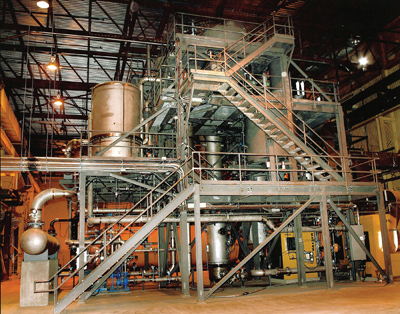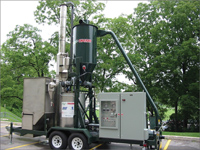
What about Bio-oil?
June 14, 2010
By Stefanie Wallace
Turning solid wood in-to liquid fuel sounds like an interesting concept. One way to do this is by pyrolysis, which involves placing biomass such as sawdust or wood chips into a reactor and rapidly heating it at extreme temperatures without oxygen.
Turning solid wood in-to liquid fuel sounds like an interesting concept. One way to do this is by pyrolysis, which involves placing biomass such as sawdust or wood chips into a reactor and rapidly heating it at extreme temperatures without oxygen. The conversion process, called fast pyrolysis, is true to its name, taking only seconds to occur. The lack of oxygen prevents combustion and breaks the biomass down into solid, liquid, and gas components. The liquid component is bio-oil, or pyrolysis oil, and can be burned to generate heat or power, processed further, or stored until needed.
 |
|
| Ensyn’s pyrolysis technology uses a tornado of sand to heat biomass to 500°C and then cool it within seconds. If the biomass has 45% or less moisture content, only electricity is required to run the pumps, conveyors, and fans. If the moisture content is more than 45%, some pyrolysis oil is used to help fuel the process. Photo: Ensyn Technologies |
Currently, a few Canadian companies are using the fast pyrolysis process to produce bio-oil. Ensyn Technologies, incorporated in 1984, has designed and built seven pyrolysis plants in North America. Its biggest, located in Renfrew, Ontario, processes about 100 bone-dry tonnes (BDt) of woody biomass daily. Dynamotive Energy Systems, incorporated in 1991, operates out of Vancouver, with offices in the United States and Argentina. Dynamotive has a standby pyrolysis plant in Guelph, Ontario, and its West Lorne plant in the same province has the capacity to process 130 BDt/day of biomass. London, Ontario-based Agri-Therm is a newer company, collaborating with the University of Western Ontario. It’s currently at the pre-commercial stage of building mobile pyrolysis plants that can be transported to the biomass; its MPS100 unit is designed to process 10 BDt/day.
But 100 tonnes of biomass doesn’t equal 100 tonnes of bio-oil. A variety of feedstocks can be used to create pyrolysis oil, including tobacco, sugar cane waste, coffee grounds, and grape residue, and the conversion rate varies with the feedstock, says Jennifer MacDonald, chief operating officer of Agri-Therm. Woody biomass is the most popular feedstock among Dynamotive, Ensyn, and Agri-Therm.
“On the pilot plant scale a few years back, we used a whole bunch of different biomass sources,” says Tom Bouchard, chief operating officer of Dynamotive. “Other feedstocks run through the fast pyrolysis process just as well as woody biomass, but woody biomass produces a higher ratio of pyrolysis oil.” Dynamotive’s conversion rate is approximately 70%, meaning for every tonne of woody biomass processed, 700 kg of bio-oil is produced. Ensyn’s conversion rate is about 70 to 75%, according to Randal Goodfellow, senior vice-president of corporate relations for Ensyn. MacDonald says that Agri-Therm’s conversion rate is approximately 60%.
Ensyn gets its feedstock of wood shavings from a neighbouring hardwood flooring company. Dynamotive uses strictly hardwood sawdust at its West Lorne facility, as it is also in partnership with a neighbouring wood flooring company. The biomass is clean when it comes from the flooring companies, but both Dynamotive and Ensyn take steps such as metal detection to ensure there are no contaminants.
The other products of fast pyrolysis aren’t put to waste. Bouchard says that roughly 15% of the output is surplus gas that’s used to power the reactor, making the process essentially self-sustaining. The other byproduct is biochar, which MacDonald says can be used for various products, depending on the initial feedstock. For example, biochar from wood can be used to add a smoky flavour to a barbeque sauce, and biochar from tobacco can be used in pharmaceuticals.
Market Challenges
The process and its products sound promising, but challenges lie between bio-oil and popularity. “It’s a completely different chemical makeup than biodiesel or ethanol. It’s not ready for transportation applications, unlike biodiesel and ethanol,” says Bouchard.
 |
|
| Instead of trucking biomass to the pyrolysis plant, Agri-Therm’s mobile pyrolysis unit goes to the biomass. Because biomass is bulky and costly to transport, this process is more cost effective, says Jennifer MacDonald, chief operating officer of Agri-Therm. Photo: Agri-Therm |
Although it has only 40 to 50% of the heating value of other fossil fuels, bio-oil can replace light or heavy fuel oils in industrial boiler applications or be used in co-firing or gasification. “Bio-oil is best positioned in stationary fuel applications, like a boiler or a kiln, where it can burn against another fuel as a second oil,” says Bouchard. He notes that because pyrolysis oil is acidic, it requires specific changes to machinery for its use. “Storage tanks and machinery need to be stainless steel or fibreglass, which isn’t a problem, but of course it takes time and money to switch over to those,” he says.
The location of the feedstock also is an issue because of the cost of transporting biomass long distances. “If you build too large of a plant for the biomass you have available, you have to start trucking in biomass from a long distance,” says Goodfellow. “This starts costing too much, both economically and environmentally.”
Bouchard agrees. “If you have customers and plants where the biomass is, you can develop a local market. There’s potential, but it takes time.”
MacDonald, Goodfellow, and Bouchard all concur that there’s significant potential for foresters to provide feedstock for the production of bio-oil. “Residual materials, bark, and sawdust are great feedstocks,” Goodfellow says. “The other part of the forestry sector most people don’t think about is the end-of-life materials, meaning construction and demolition materials. There are more and more jurisdictions globally that are making the forestry sector responsible for the end-of-life materials, and that is good feedstock for the process.” However, because the market is in its infancy, there is no established economy for bio-oil, and the potential goes unfulfilled.
Despite the challenges, bio-oil proponents stress the benefits of bio-oil. “It has 50% of the nitrogen oxide compounds that are found in fossil fuels,” says MacDonald. It also has low sulphur content.
Then there are the improved economics of transporting bio-oil rather than raw biomass. “We feel it’s an economical way of concentrating a natural source of energy,” says Bouchard. “You’d have to have about five trucks of sawdust to get the equivalent BTUs as two trucks of bio-oil,” he says. “We believe the bio-oil process is a good way of getting the energy in as small of a package as possible from nature to the industrial application.”
Goodfellow is optimistic about market development. “We have many different market applications and market timings. There are a lot of uses for pyrolysis oil that are yet to be developed,” he says, noting that Ensyn’s current market includes specialty chemicals and stationary fuels. “The demand is growing,” he adds. “We’re deploying with companies that have their own biomass and have their own thermal or electrical needs.”
MacDonald is also optimistic. She thinks that developing a market for bio-oil will be a task to embrace because of the benefits. “I don’t think it’s going to be a huge challenge to place the bio-oil and biochar,” says MacDonald. “It’s all beginning, and it’s very exciting.”
Print this page